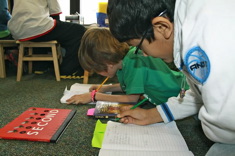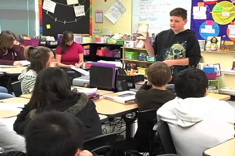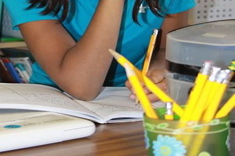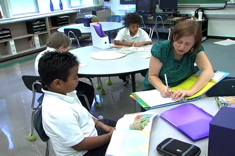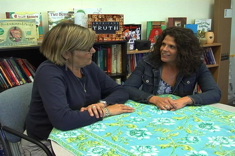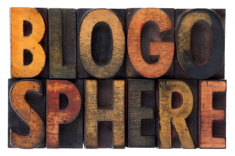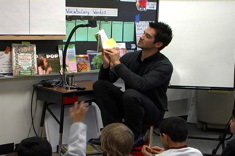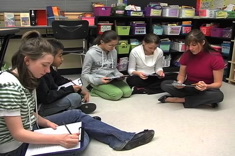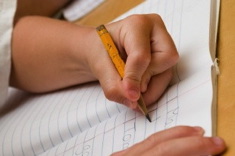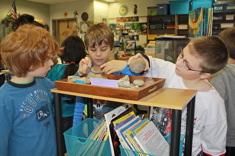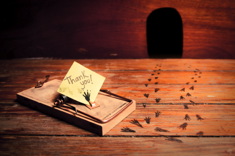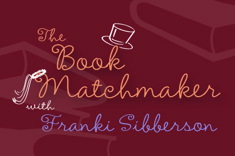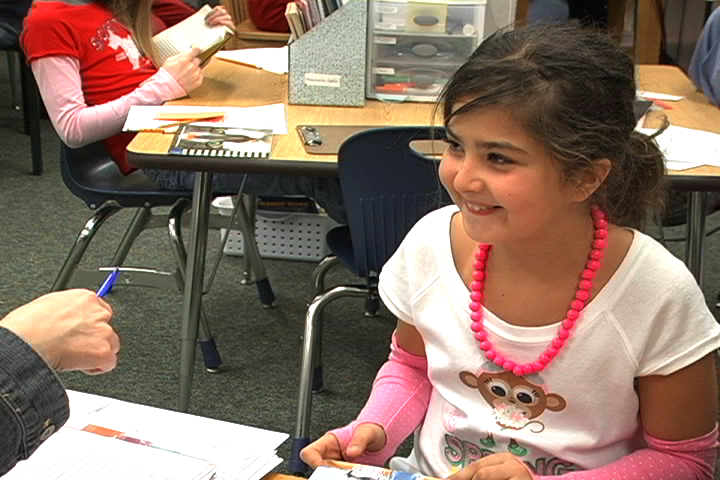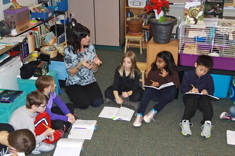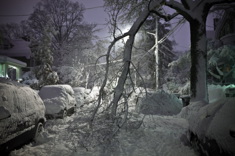Library
Choice Literacy Articles & Videos
The Choice Literacy library contains over 3,000 articles and 900 videos from 150+ contributors. Classic Classroom and Literacy Leadership subscribers have access to the entire library. Content is updated continuously, with five to six new features published each week.
Latest Content
Procedural Writing in Math
Heather Rader explains how mentor texts for math instruction need some specific attributes.
Student Book Talks
In this second video in a two-part series, Katie Doherty's sixth-grade students share their book recommendations with the class. Students work from a template provided by Katie to ensure their presentations are brief, thoughtful, and connected to reading workshop.
Pencil Plans
The care and use of the lowly pencil in classrooms says a lot about what we value and our relationships with students.
Book Clubs: Setting the Stage with Conferring
We want students to discuss books in thoughtful, sophisticated ways in book clubs, but those skills don’t always come naturally. (Wait – do those skills ever come naturally?) Beth Lawson explains how she confers with individual children in her third-grade classroom to prepare them for independent book clubs with peers.
From Teacher to Coach: Building Community in the Early Days
The transition from teacher to coach is tricky. Melanie Quinn has advice for building relationships with colleagues in the first weeks of school.
You Never Know What You’re Going To Get
When students help us organize materials, we are often pleasantly surprised at the results.
Persuasive Pamphlets
Erin Ocon and her middle-school students observe some political activists passing out pamphlets outside the building for a few moments. Voila – the pamphlet project is born. Pamphlets are the perfect genre for teaching persuasion and summary, two key skills highlighted in the Common Core.
5 Easy Steps for Starting a Blog
Mary Lee Hahn and Franki Sibberson share tips for launching and maintaining a blog, as well as a wealth of reasons why it’s a valuable use of your time
Science Writing Workshop Part 1
How can teachers connect the principles of writer’s workshop with science explorations? In this first of a three-part video series, Jennifer Morgan leads her 3rd and 4th students through the process of observing, talking, and writing in their science journals as they perform an experiment. In Part I, she presents the task to students and connects it with previous learning.
Content Connections in Reading Workshop
In this four-minute video, Andrea Smith confers with a 4th grade student interested in immigration, helping her set up an independent reading and learning plan.
Relentless Consistency: Finding a Common Teaching Language Without Scripts
Sharing a common teaching vision begins with a common language, but not a script. Clare Landrigan and Tammy Mulligan share how teachers can work together to develop consistent ways of talking about literacy learning.
Read Alouds for the First Day of School
Choice Literacy readers share their favorite read alouds for the start of the year.
Quick Take: Conferring with Young English Language Learners
In this short video, Ruth Shagoury gives advice to teachers conferring with young English language learners, explaining how other English language learners can be surprisingly helpful in conferences.
Linking Reading, Writing, and Getting to Know You Activities During the First Week of Middle School
Want to get your middle school students’ attention on the first day of school? Read a book about how to ruin it for them.
“To Teach is to Learn Twice”: Creating Professional Communities in Schools
What are the hallmarks of professional learning communities that work well in schools?
Pamphlets on Books (Part 2 of the Persuasive Pamphlets Series)
Erin Ocon finds pamphlets are a terrific format for teaching her middle-school students persuasive writing and summary skills. In this essay she explains how to use pamphlets for book recommendations. This is the second installment in a two-part series.
Coaching Beyond the Curriculum: Reframing Our Talk and Attitude Toward Difficult Students
What role should literacy coaches have in helping teachers manage unruly students? Melanie Quinn settles into a morning of poring over assessment data, only to have it interrupted by a child who has been disrupting his class. Her interactions with Darren and his teacher lead to strategies for helping colleagues take an inquiry stance with challenging children.
First Grade Guided Writing Group: Targeting Common Spelling Needs
In this video of a 1st grade guided writing group, Katie DiCesare works with children to address common issues with spelling and conventions. By grouping the students together, she is able to use her time well in addressing common needs among students.
What Velcro Can Do: Science, Literacy and Coaching Connections
No time for science? Don’t like messes? Heather Rader works with a teacher and helps her find a way to fit science neatly into her full teaching day.
Ways to Avoid Coaching Traps
There are many traps for new literacy coaches that are rarely discussed. Clare Landrigan and Tammy Mulligan share the most common four they try to avoid.
Book Matchmaker: A Friendship Theme for Literature Circles
Franki Sibberson shares her top picks for literacy circles with a friendship theme. This is an excellent theme for building community any time of year.
Book Matchmaker: Short Vowel Practice with Older Students
In this installment of Book Matchmaker, Franki Sibberson tackles the tough question of how to find texts for students who need help with short vowels, but are too old to enjoy many primary texts.
Using Picture Books to Spice Up Vocabulary Instruction (BOOKLIST)
Picture books are a terrific tool for vocabulary instruction – students have so much fun reading them they are hardly aware of all the new words they are picking up. Franki Sibberson shares her top picks for spicing up vocabulary instruction in this booklist.
Helping Children Build Notetaking Skills
Whose job is it to teach notetaking skills? Heather Rader finds teachers often expect colleagues in previous or subsequent grades to teach these skills, as well as a lot of hesitancy about how best to instruct students. She presents a simple notetaking template and describes how she uses it to help students learn how to list important details with words and images.
“What Will You Do with This Mess?”: Helping Students Learn to Collaborate
Sometimes classroom disruptions are rooted in different learning and work styles among children. Andrea Smith finds her attempt to settle a dispute between students about project collaboration helps her face some truths about her own work style.
An Uncommon Place
A mulberry tree crashes during a blizzard, creating a surprisingly lovely mental space for Shirl McPhillips to craft her poem.
Preschool Book Browsing Time
This five-minute video from Kelly Petrin's preschool classroom shows the value of book browsing time. Kelly explains the skills children develop in language, book handling skills, and literacy independence during this time.
Great Little Books for Professional Book Clubs
What books are most likely to succeed in teacher study groups? Shari Frost shares her criteria for books teachers will embrace. . .and actually read with enthusiasm.
Primary Series Study
Katie DiCesare describes the primary series study unit she completes with her 1st and 2nd graders, combining reading, writing, and community building.
Browse Content By
Type
Category
- Assessment Tools
- Big Fresh Archives
- Booklists
- Choice Numeracy
- Classroom Design
- Common Core
- Community Building
- Conferring
- Content Literacy
- Digital Literacy
- English Language Learners
- Equity
- Family Relations
- Free Samples
- Guiding Groups
- Leadership
- Literacy Coaches
- Mentor Texts
- Minilessons
- New Teacher Mentors
- Podcasts
- Poetry
- Quote Collections
- Reading Strategies
- Self Care
- Struggling and Striving Learners
- Talking and Listening
- Teacher Study Groups
- Teaching Reading
- Teaching Writing
- Word Study and Vocabulary
Author
- Melissa Quimby
- Nawal Qarooni
- Gwen Blumberg
- Julie Cox
- The Lead Learners
- Hannah Tills
- Josie Stewart
- Ruth Metcalfe
- Mallory Messenger
- Becca Burk
- Jodie Bailey
- Vivian Chen
- Mary Brower
- Tiffany Abbott Fuller
- Stephanie Affinito
- Ruth Ayres
- Leigh Anne Eck
- Heather Fisher
- Shari Frost
- Julie Johnson
- Suzy Kaback
- Gigi McAllister
- Shirl McPhillips
- Melanie Meehan
- Cathy Mere
- Debbie Miller
- Tara Barnett and Kate Mills
- Tammy Mulligan
- Dana Murphy
- Bitsy Parks
- David Pittman
- Brenda Power
- Heather Rader
- Matt Renwick
- Mandy Robek
- Christy Rush-Levine
- Gretchen Schroeder
- Jen Schwanke
- Brian Sepe
- Katherine Sokolowski
- Stella Villalba
- Jennifer Vincent
Grade Level
Choice Literacy Membership
Articles
Get full access to all Choice Literacy article content
Videos
Get full access to all Choice Literacy video content
Courses
Access Choice Literacy course curriculum and training

